Remember that scene in a movie where a kid runs into their home, and a fluffy dog rushes to greet them? That joy can be your everyday reality when you choose the perfect dog for your family. But how do you pick the right breed? With various fun-loving options out there like Golden Retrievers and Poodles, each brings unique charms that fit different family dynamics. Stick around to discover which furry friend could be your child’s new best buddy.
Top Family-Friendly Breeds
When you think about getting a dog for your family, some breeds just seem to be perfect matches.
Take the Golden Retriever, for example; their friendly nature and loving temperament make them a hit with kids.
Then there’s the Poodle, whose smarts and playful spirit will keep everyone entertained—just try to keep up with their energy level, right?
1. Golden Retriever Temperament
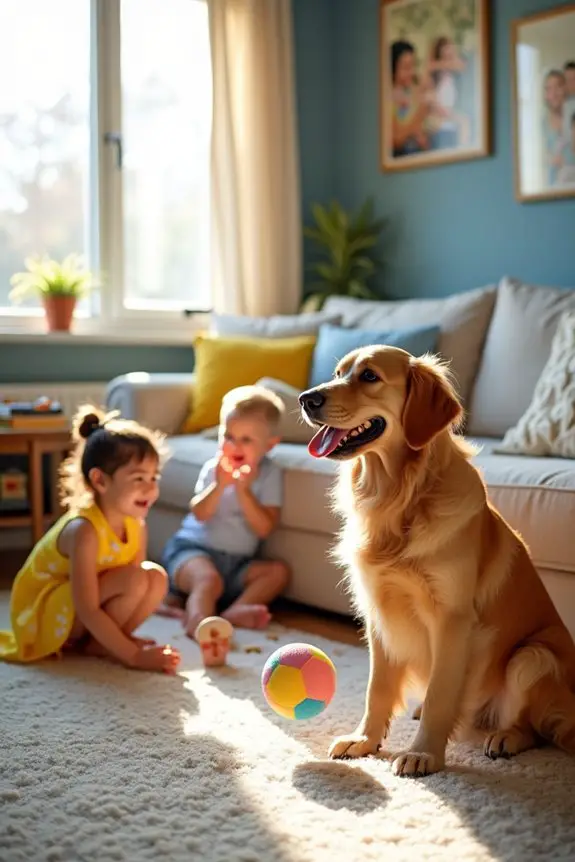
Introducing a Golden Retriever into your home can be one of the best decisions for your family’s happiness. These fluffy bundles of joy are known for their friendly demeanor, gentle spirit, and unwavering loyalty, making them the ideal companions for kids. Not only do they bring a certain warmth and cheer to the home, but they also foster an environment where kindness and responsibility can flourish. Plus, who doesn’t love a dog that can make any day instantly better?
So, how do you guarantee your Golden Retriever becomes the perfect family pet? First off, start with early socialization. It’s like sending them to puppy school, where they learn the ropes of interacting with other dogs and humans. If you can, expose them to a variety of people, environments, and situations while they’re still young. Think of it as giving them a crash course in being the most sociable dog on the block.
Next, incorporate some training into playtime. It sounds fancy, but it’s really quite simple. Use fun games paired with commands—like “fetch” or “sit”—to teach them discipline while having a blast. It’s like jogging while eating ice cream; it balances out neatly, right?
Start with short training sessions, making it playful and rewarding. And trust me, a treat or two doesn’t hurt. Your Golden will soon associate learning with fun, making them enthusiastic to show off their skills to the family.
Another important tip is to create a safe and loving environment. Golden Retrievers are sensitive souls who thrive on companionship. They don’t do too well in isolation, so include them in family activities. Whether it’s a movie night on the couch or a picnic in the park, having your pup around won’t only keep them happy but also instill a sense of togetherness in your kids.
Plus, visualize this: kids laughing, a dog wagging its tail, and everyone just enjoying each other’s company. It’s priceless.
Lastly, always remember to establish boundaries. Setting clear rules from the start helps your Golden understand what’s expected of them, which allows for a smoother coexistence. Kids can help with this, as explaining how to treat their furry friend gently and respectfully can bring a nice bond between them.
It’s a chance for little ones to practice responsibility, and before you know it, they’ll be caring for their dog like seasoned pros.
In a nutshell, bringing a Golden Retriever into the family is like adding a sprinkling of sunshine to your daily life. With the right guidance, they can grow to be loving friends and guardians for your children, creating memories you’ll cherish forever. Furthermore, providing them with premium dog food tailored for their nutritional needs can significantly enhance their well-being and energy levels. Regularly including premium dog food subscriptions can simplify your commitment to their dietary health.
2. Poodle’s Intelligence and Playfulness
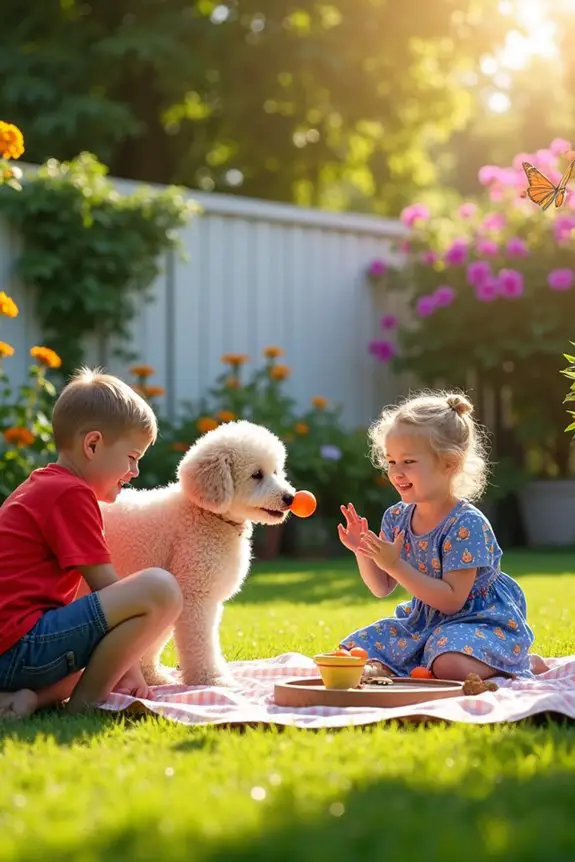
When thinking of a dog that can bring both joy and a sense of adventure to your family, the Poodle is right up there at the top of the list. With their incredible intelligence and playful nature, Poodles aren’t just your average pet; they become a true member of the family. Imagine your kids giggling as they play games, while your Poodle masterfully balances a toy on its nose. It’s not just a fun visual, but it also fosters warm memories that your family will treasure for years.
One of the best ways to tap into a Poodle’s intelligence is through interactive toys and puzzles. These clever canines thrive on challenges, so think of it as giving them a little workout for their brains. You can start simple—maybe a classic Kong toy stuffed with peanut butter or some dog-safe treats. As your pup gets the hang of it, switch to more challenging puzzles that require them to think things through. Trust me, they’ll get super excited, wagging their tails like they’ve just solved a mystery worthy of Sherlock Holmes. Investing in premium dog enrichment toys can help keep their minds engaged and satisfied. Additionally, incorporating interactive dog playground equipment can provide a dynamic environment that increases their physical activity and fun.
And here’s a tip: rotate their toys to keep things fresh. It’s like the doggy version of getting a new video game, and it keeps their interest piqued.
Pairing their playtime with training is a surefire way to maximize their potential. Incorporating commands into their play won’t only sharpen their skills but will also strengthen the bond between your kids and your Poodle. Consider a game of “hide and seek” where your kids hide, and your Poodle has to find them based on verbal cues—how fun is that? It’s like a family treasure hunt, with your fluffy friend as the star of the show.
And remember to keep it positive; using treats as rewards can help them associate learning with joy. If you’ve ever watched a kid and dog share a sighting of a long-lost squeaky toy, you know the laughter that follows is contagious.
Socialization is another crucial aspect of having a Poodle in the house. These dogs absolutely thrive on human interaction and love being part of the family action. Make it a family affair: take your Poodle on outings to parks, dog-friendly cafes, or even just a stroll around the block. It’s a great way to teach your kids about kindness toward animals and helps your Poodle experience various sights and sounds. Plus, investing in a luxury grooming kit ensures your pet looks as good as they feel during these outings.
Let’s face it: nothing brightens a day quite like a dog bounding through the grass with sheer joy, can it? That’s the energy we all need sometimes.
Finally, set some clear boundaries from day one. Establishing ground rules about how to treat your Poodle and what behaviors are acceptable will help shape your pup into a well-mannered companion. Encourage your kids to be gentle and engage with their furry friend correctly.
This not only helps maintain peace at home but teaches kids a sense of responsibility that will follow them throughout life. Plus, when they learn to respect the boundaries, it becomes a win-win, making playtime even more enjoyable for everyone involved.
3. Beagle’s Friendly Nature
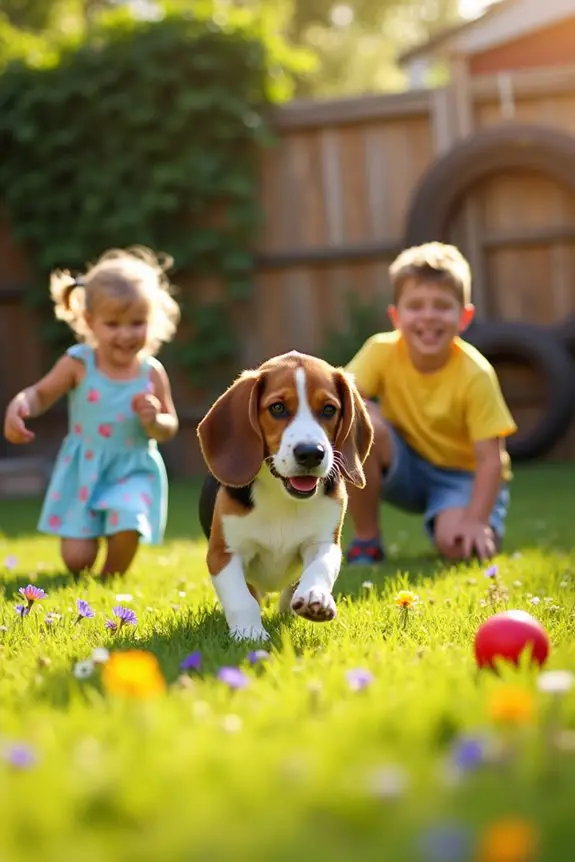
When it comes to choosing a dog breed for your family, the Beagle might just take the cake for its friendly nature. These lovable hounds aren’t only adorable with their floppy ears and soulful eyes, but they also bring a warmth and joy to any household. They’re the type of furry friends that kids dream of having—always ready to play, go on adventures, and share a snuggle. Sounds pretty idyllic, right?
To make the most of having a Beagle in your home, start with regular playtimes that allow their exuberant personality to shine. Think of simple activities like fetch or tug-of-war. Beagles are natural explorers, so let them use their noses on a fun scavenger hunt around the house or yard. You can hide their favorite toy or some treats and give them a clue.
Watching them use their keen sense of smell is like having a little detective in your family; how cool is that? Just remember, they can get a bit carried away with their nose, so keep an eye out for any off-limits treasures they might uncover.
Training is essential to channel that lively Beagle energy effectively. Positive reinforcement works wonders for these pups. Consider teaching them fun commands or tricks that your kids can help with. Imagine your little ones cheering on their Beagle as he learns to roll over or play dead.
When they succeed, reward them with treats or enthusiastic praise—who doesn’t love applause for a job well done? A well-trained Beagle also means less chance of puppy mischief, which is a win for everyone involved.
Socializing your Beagle can deepen those family bonds while showing them the world outside your front door. Take them on leisurely walks around the neighborhood or to local parks where they can mingle with other dogs and people. The excitement on a Beagle’s face while sniffing out new scents is a love letter to adventure itself.
Plus, it’s a fantastic way for your kids to learn about sharing their space and being kind to animals—important lessons wrapped in a fun outing. You’d be amazed at how much happiness can be found in a wagging tail and a happy bark during these trips.
Lastly, establishing routines is key. Beagles thrive on consistency, so setting up a schedule for feeding, play, and training makes them feel secure. You could create a fun chart for your kids to help keep track of these routines.
Involve your children in feeding time or leash lessons—because what’s cuter than watching your kid walk a Beagle almost their size?
4. Labrador Retriever’s Affectionate Personality
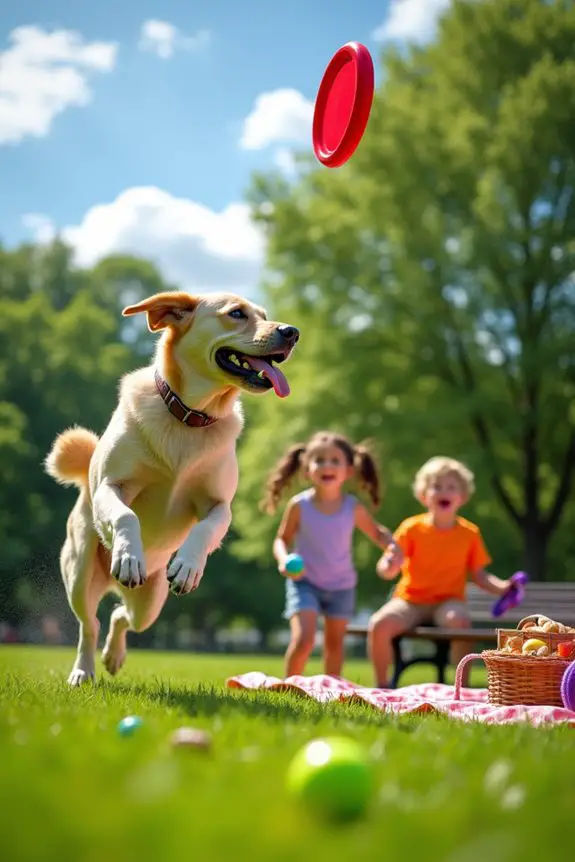
When you think of a dog that’s perfect for snuggling and playing, the Labrador Retriever often pops to mind. Known for their affectionate nature, these pups have a heart as big as their goofy smiles. With their friendly demeanor and playful energy, it’s no wonder they’ve a reputation as one of the top family-friendly breeds. Plus, they’ve a talent for making everyone feel like the best of friends—even that neighbor who usually keeps to themselves.
To nurture your Labrador’s affectionate personality, consider incorporating playtime into your family’s daily routine. Lab puppies are notoriously energetic, so games like fetch or frisbee aren’t just fun—they’re vital for keeping their tails wagging and their hearts happy. You might find yourself getting your workout in while trying to keep up with their playful antics, which is a nice bonus.
When they bring the ball back, the happiness on your Labrador’s face is irresistible. I mean, can you imagine being greeted by that kind of joy after a long day?
Training is also a significant step in fostering that familial bond. Labs love to learn, and they thrive on positive reinforcement. You can practice commands like “sit” or “high-five” in a fun, engaging way. Why not turn it into a little competition among the kids? Whoever helps the most during training gets to claim the title of “Best Dog Trainer” for the week.
Trust me, kids love a little friendly competition, and your Labrador will soak up the attention like a sponge.
It’s also important to socialize your Lab. Take them on family outings, whether it’s a trip to the park or a walk around the neighborhood. Interacting with other dogs and friendly people will enhance their outgoing nature, making them even more of a family favorite. Plus, it’s an ideal chance for your kids to learn about responsibility and respect for animals.
Picture a family stroll with everyone’s favorite furry friend bounding ahead, leaping with sheer joy at every new scent or sight. That’s the kind of memory you’ll cherish.
Lastly, establishing a daily routine can help your Labrador feel steady and secure. From regular feeding and playtimes to designated training sessions, consistency is key. You might try creating a colorful chore chart that includes fun stickers for your kids to place every time they help with caring for their furry sibling.
Trust me, nothing brightens up a generally dull, gray day like the sight of a proud kiddo marveling at their sticker collection while walking their Lab.
In short, while Labradors bring their love and energy to your home, it’s the little steps you take together that build that affectionate bond. So go ahead, grab a ball, and let the cuddles and chaos begin.
5. Bichon Frise’s Gentle Demeanor

When you think of the Bichon Frise, the first thing that probably comes to mind is their fluffy, cloud-like coat and sweet little face. These dogs are known for their gentle demeanor, making them an exceptional choice for families, especially with young kids. They mightn’t be the biggest pooches on the block, but their loving personalities and playful spirit can light up any household.
So, how do you best welcome this endearing breed into your family? Let’s explore some heartwarming ways to bond and create a nurturing environment for your Bichon Frise.
First and foremost, make a cozy nook just for them. A dedicated little corner with a soft bed, their toys, and perhaps a blanket that smells like you’ll help your Bichon feel right at home. You can even encourage the kids to personalize this space with drawings or a little sign with your dog’s name on it.
Let me tell you, there’s nothing quite like seeing a kid’s proud smile when they’ve created a special spot for their furry friend.
Next up is playtime. Bichons love to frolic and engage in gentle games, making play an important part of their day. Grab a few squeaky toys or a soft ball—trust me, they won’t be able to resist! You can set up a mini obstacle course in your living room using cushions and chairs.
It’s like a mini agility course that’s more fun than a trip to the fair. The whole family can join in, watching and cheering as your little Bichon zigzags around, tail high and a goofy grin plastered on its face. Sometimes, I think my Bichon could outplay a toddler when it comes to zoomies, and honestly, it’s a sight that gives me all the giggles.
Socializing your Bichon is another vital step. These pups thrive on companionship, so invite your friends over for a doggy play date or take them to a local dog park. Not only will this help them become more confident, but it’s a perfect opportunity for your kids to learn important social skills—like sharing toys and playing nice, even when the squeaky ball gets mighty competitive.
Remember the time you tried to break up a doggy tangle only to realize it was just a perfectly orchestrated game of tug-of-war? Priceless.
Don’t forget daily grooming! Bichons require regular brushing to keep their coats looking fluffy and fabulous. It’s an excellent chance for you and the kids to bond with your pup while working together.
You might even turn it into a reward system, where your kiddo gets to choose a fun movie night each time they help groom. Just, you know, maybe avoid the neighbor’s eyes on that first try—they might think you’ve transformed your living room into a hair salon for dogs. But hey, a little fluff never hurt anyone, right?
Finally, remember that routine is key. Bichons settle quickly into a structured environment. You can set up a daily schedule that the kids can help keep track of, marking off feeding times, walks, and playdates.
Get everyone involved and maybe add a little flair, like doodling cute dog bones or paw prints on a family calendar. Keeping it visually fun can help everyone stay on track, and you’ll all be rewarded with a happy, well-adjusted pup.
With all these ideas, welcoming a Bichon Frise into your home can be an exciting adventure filled with love, laughter, and a bunch of happy tail wags.
Who knew a ball of fluff could bring so much joy? So, are you ready to jump into this fluffy journey?
6. Cavalier King Charles Spaniel’s Sociability
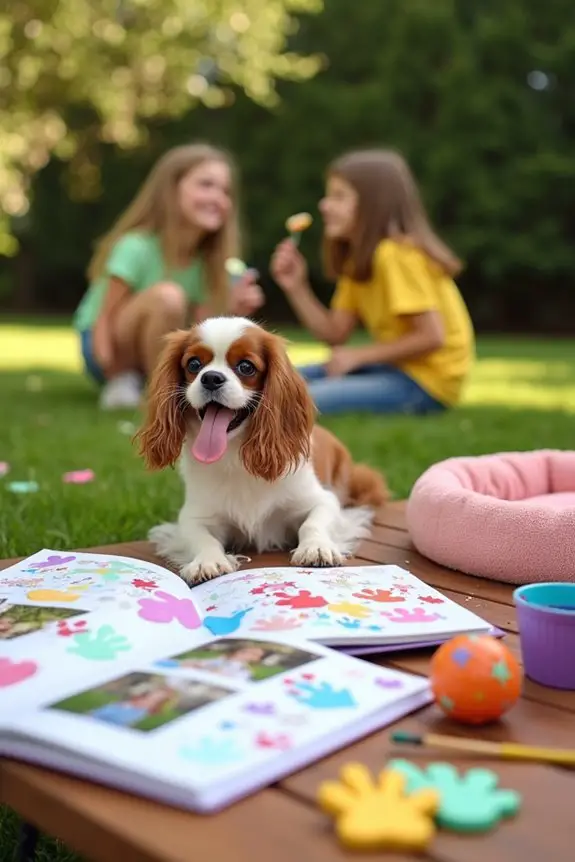
When you’re welcoming a Cavalier King Charles Spaniel into your family, you’re not just adding a dog; you’re inviting a lovable, fluffy bundle of joy into your home. Known for their sociability and affectionate nature, Cavaliers make outstanding companions for kids and families.
So, how can we best nurture this charming little soul and encourage their friendly spirit? Let’s explore some heartwarming ideas that will have your Cavalier feeling right at home while strengthening the bond with your kids.
One fantastic way to welcome your Cavalier is by establishing a “family fun day.” This means setting aside a specific day each week where everyone can participate in activities revolving around your new furry member. From going on a family walk to the park to engaging in a lively game of fetch, these moments create a joyful atmosphere that helps both your kids and the Cavalier to thrive.
Try to involve everyone in planning the day. Create a chore chart that includes responsibilities for caring for their new buddy, like feeding, grooming, or training sessions. Trust me, there’s something delightfully hilarious about watching kids argue over who gets to hold the leash!
Another terrific idea is creating a Cavalier-themed craft day. Gather your supplies—colored paper, markers, stickers, and even fabric scraps. The kids can make personalized dog tags or even a scrapbook to document your Cavalier’s adventures.
Why not have a contest to see who can come up with the best dog-themed art? This not only sparks creativity but also helps children develop a sense of pride in their new best friend. Just imagine the giggles when your little one tries to capture the perfect snapshot of the Cavalier mid-yawn—it’s a moment for the memory books.
Training sessions can be a fun family affair as well. These pups are enthusiastic to please, so teaching them tricks can be both a rewarding endeavor and a bonding experience. Get the kids involved by using treats and praise to reinforce good behavior.
Everyone can take turns being the “trainer.” Maybe you’ll end up with a Cavalier that can jump through hoops or spin in circles on cue. Just remember, every time your child leans down to give a treat, there’s a good chance of getting some slobbery kisses in return, so be prepared for the giggles about that too.
Don’t forget about socialization! Arrange playdates with other dogs or invite over friends with their own pets. Watching your Cavalier gladly greet new friends with wagging tails can evoke some heartfelt moments.
This not only helps your pup to be more confident but also gives your kids valuable lessons in sharing, patience, and camaraderie. Afterward, come home and spend some time talking about your outings over a snack. Perhaps it’ll turn into a family favorite memory, nostalgia-filled with stories about your Cavalier’s quirky impressions of other dogs.
Bringing a Cavalier King Charles Spaniel into your home is a beautiful way to create lifelong memories for your family. By incorporating family fun days, craft sessions, training together, and socializing with other dogs, your Cavalier will feel immensely loved and cherished.
You’ll not only foster a strong bond with your furry friend but also watch your kids grow in empathy and companionship. And just wait for the smiles when sharing those delightful, silly moments that only come from life with a Cavalier.
7. Boxer’s Energetic Playfulness

When it comes to adding a Boxer to your family, you’re welcoming a whirlwind of energy and playfulness into your home. Known for their playful antics and boundless enthusiasm, Boxers are often described as the class clowns of the dog world. So, how can you channel that delightful energy into wholesome family fun? Let’s explore one exciting idea that will keep both your kids and your Boxer moving and grooving together.
How about organizing a family “Boxer Olympics” right in your backyard? This playful competition not only allows you to expend some of that wiggly energy, but also promotes teamwork and bonding among family members. To set this up, create various challenges that play into your Boxer’s natural talents.
For instance, you could include a friendly agility course, which might consist of chairs to weave through, a jump made from a broom laid across two milk crates, or a “fetch and retrieve” race where kids race against each other and their Boxer. There’s nothing quite like watching your kids cheer for their furry teammate as he barrels through the course. Am I right?
When planning your event, it’s great to have a mix of physical challenges and mental tasks. Think about including an obedience challenge where kids can show off the commands they’ve taught their Boxer, or even a “best trick” contest. Just remember to have lots of treats on hand—it’ll be your dog’s version of an ice cream sundae, and it’s sure to keep the excitement bubbling!
Don’t forget about a fun awards ceremony at the end. You could fashion some homemade medals from cardboard and stickers for winning categories like “Fastest Boxer” or “Best Sniffer.” Each kid just might become a proud champion in their own right.
And who knows? You might find that you’re the one laughing the hardest as your Boxer mistakenly runs off with the medals or, you know, rolls in something smelly right before the grand finale. Dogs always know how to keep it real, don’t they?
This idea not only creates lasting memories filled with laughter and competition but also guarantees your Boxer gets the exercise they so joyfully need. Plus, it strengthens those beautiful bonds between your kids and your playful pooch, all while being an absolute blast.
8. French Bulldog’s Adaptability for Families

When it comes to choosing a family dog, the French Bulldog stands out for its sweet disposition and tremendous adaptability. They may be small in size, but these little bundles of joy bring big love into any household. Positioned perfectly for family life, French Bulldogs are calm yet affectionate, making them a delightful companion for kids and a perfect addition to homes of all situations, whether apartments or large houses.
But how can you make the most of this adorable breed in a family setting? Let’s plunge into creating a cozy and engaging “Frenchie Family Night” that showcases their charm while fostering family bonds.
To pull off this Family Night, start by setting the scene. Find a comfy spot in your living room or backyard and create a little haven for your French Bulldog. Think soft blankets, their favorite toys piled up, and maybe a few treats scattered around to spice things up. You could even grab some trendy cushions for the kids and arrange them to sit alongside your pup. Make it inviting—it’s all about creating a warm and relaxed vibe. You want everyone to feel at home, laughter flowing as freely as the snack bowl.
Now, onto the activities. One fantastic idea is to host a “Frenchie Fashion Show.” Who could resist dressing up their little buddy in silly (but safe) outfits? Think dapper bow ties, cute hats, or maybe a superhero cape—whatever captures your family’s creativity. You’ll set up a runway (a.k.a. a hallway or a large blanket spread out) and let your kids guide their Frenchie as they strut their stuff. Adding some playful commentary can really amp up the fun. “And here comes Buster, looking dashing in his striped bandana!” Just be sure to keep it light-hearted; your dog is there for the experience, not to become the next runway model.
Of course, don’t forget your Frenchie’s favorite treats while vaunting their style. You might make it a contest where the best-dressed pup wins a special snack! Consider having the kids vote (with the criterion being pure cuteness, of course) to save any family squabbles—though I’m sure they’ll debate endlessly over who’d the “cutest” fashion choice.
Another great activity could be a cozy movie night featuring dog-themed films. This could be the perfect way to wind down as everyone cuddles next to your French Bulldog, who’ll surely enjoy snuggling up with the family. Think about classics like “Lady and the Tramp” or fun flicks like “The Secret Life of Pets.” To set the perfect mood, grab popcorn for the kids and some dog-friendly treats for your pup. Letting them enjoy some special goodies while you munch away will fill the night with joy.
Ultimately, a Frenchie Family Night not only provides laughter and togetherness but also strengthens those special bonds between your children and their furry friend. It showcases how adaptable and loving French Bulldogs can be in a family environment. So, grab some costumes, prepare for some movie magic, and let the fun unfold, all while cultivating those beautiful memories that you and your Frenchie will cherish forever.
Who knew family time with your little canine could be such a delightful adventure?
9. Pit Bull’s Loyal Nature

Creating a cozy and engaging “Frenchie Family Night” works wonders for bonding with your French Bulldog while celebrating the playful side of family life. It melds fun with functionality—offering your pup a chance to shine while bringing everyone together for lighthearted entertainment. Who knew that a little planning could release so much joy? Get ready for laughter, togetherness, and those moments of sweet connection that make family time unforgettable.
To kick things off, gather blankets, comfy cushions, and a few of your Frenchie’s favorite toys. You want a space that screams “fun” while making your pup feel right at home. Maybe your living room‘s the spot; just toss a few colorful blankets around to create a snug area that invites everyone in. With treats scattered around, who can resist joining the fun? It’s like rolling out the red carpet, only fluffier and filled with love.
Don’t forget to keep the vibe relaxed—snacks for the kids and cozy spots for the dog are your best friends here.
Now, let’s plunge into the flagship activity: the “Frenchie Fashion Show.” What could be more entertaining than watching your kids release their creativity on your pup? Grab those silly outfits—dapper bow ties, goofy hats, or, yes, even a superhero cape—anything goes, as long as it’s comfortable for your dog. Set up a little runway using a hallway or a wide space in your living room, because who doesn’t love a little drama? Let the kids take charge as they guide your Frenchie down the runway. The giggles are sure to erupt, especially if you throw in some tongue-in-cheek commentary.
“And here comes the adorable Mabel, rocking that tutu like a true superstar.” Just make sure the fashion choices are safe and easy for your dog to wear.
Think about adding a twist—a tiny contest for the best outfit. Use a simple voting system where each kid gets to cast their vote based on pure cuteness. Yes, there will be debates over who dressed their pup the best, and you might find yourself on the couch, chuckling at their passionate discussions. The prize? Maybe an extra special treat for the winning pup. Nothing like a delicious reward for being a top dog, right?
After the fashion frenzy, why not cool down with a movie night? There’s nothing quite like curling up together for a dog-themed film. Picture your family nestled together, munching on popcorn, while your Frenchie snuggles in for some quality time. Choose classics like “Lady and the Tramp” or something that will have everyone giggling, like “The Secret Life of Pets.”
The best part? You’ll have the perfect setting for heartwarming cuddles and shared laughs. Just keep an eye on your Frenchie—who knows, they may snatch a stray piece of popcorn or two when you’re not looking.
In all, crafting a “Frenchie Family Night” is a delightful way to bond with your pup. It’s all about creating a joyful atmosphere where fun reigns supreme and laughter is the soundtrack of the evening. So gather your family, embrace the silliness, and make some cherished memories that you’ll laugh about for years to come.
10. Shih Tzu’s Loving Companionship

When it comes to choosing a dog breed for the family, the Shih Tzu shines bright as a loving companion. This affectionate pup has a charming personality and a knack for bringing people together, making it a perfect match for households filled with kids. Their loving disposition creates a warm and welcoming vibe that you’ll want to wrap around your family like a cozy blanket.
Let’s explore a fun idea to bond with your Shih Tzu and make lasting memories—how about a “Shih Tzu Story Night”? This cozy evening can be a delightful way to get the kids involved while letting your pup bask in your love and attention. To set the stage, gather a few favorite bedtime stories—whether they’re silly tales about dogs going on adventures, or enchanting fairy tales filled with magic.
Find a comfy corner in your living room, complete with fluffy pillows, warm blankets, and of course, some treats for both the kids and your Shih Tzu. You want everyone to feel as snuggly as possible.
Now, here’s where the fun really begins. As you read the stories, let the kids take turns narrating, with your Shih Tzu right there by their side. Encourage them to act out characters—maybe they can put on puppet shows using their hands and the dog can be the special guest.
Picture it: your child dramatically declaring a fairy prince’s line while your Shih Tzu looks up with those big, shimmering eyes, as if he’s right in the fairy tale. Sounds like a scene out of a heartwarming movie, right?
Using props can add an extra layer of magic. Perhaps you have some hats, capes, or even stuffed animals to bring the stories to life. Don’t worry if the Shih Tzu chooses to take a nap mid-story; that’s part of their charm. Just gently pat them and give them a treat for being the best listener.
Speaking of treats, here’s a tip: make some yummy homemade dog biscuits together with the kids earlier in the day. Not only is it a fun kitchen activity, but it guarantees your Shih Tzu has a tasty reward to munch on during the stories. Baking with kids can get a little messy—like flour flying here and there—but that’s all part of the fun.
Once the stories wrap up, finish off the night with some quiet cuddle time. It’s the kind of sweet bonding moment that brings everyone closer together, and trust me, everyone will be fighting for the best cuddle spot.
Plus, you might notice how easily your Shih Tzu fits right in, like a little furry piece of the puzzle, providing warmth and love to the whole family. In the end, it’s more than just storytime; it’s about the connections you create and the joy that fills the air.
Dog Training Essentials
While owning a dog can be one of life’s greatest joys, training them can feel like trying to teach a cat to fetch—frustrating and often comical.
If you’re lucky, you’ve already chosen one of the best dog breeds for kids, which means you’re off to a great start.
Start with basic commands like “sit” and “stay.” Use treats and praise as your secret weapon—trust me, they work wonders.
Keep training sessions short and fun; after all, no one likes a chore. Consistency is key; practice a little every day.
Remember, it’s not all serious business—make it playful. If your pup flops over mid-command, well, you’ll just need to laugh it off and try again.
You’re in this together.

Hi, I’m Ali Tarek, the founder of Animalsman. I’ve always been passionate about pets, especially dogs and cats, and I created this website to share practical tips, easy recipes, and helpful care advice for fellow pet lovers. My goal is to make pet care simple, enjoyable, and accessible for everyone. When I’m not writing or curating content, you’ll usually find me spending time with my furry friends or learning new ways to keep them happy and healthy.



